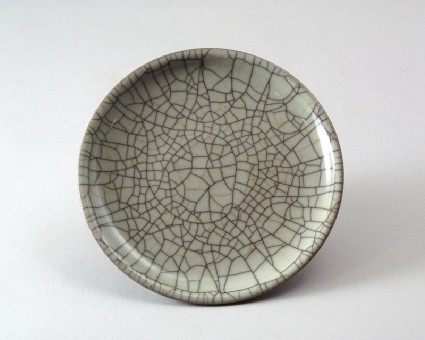Browse: 2266 objects
Dish in the style of Guan ware
- loan
-
Details
- Associated place
-
Asia › China › Jiangxi province › Jingdezhen › Jingdezhen kilns (place of creation)
- Date
-
18th century (1701 - 1800)
Qing Dynasty (1645 - 1911)
- Material and technique
- porcelain, thrown, with bluish-grey crackled glaze
- Dimensions
-
2.4 cm (height)
15.9 cm (diameter)
at foot 5.6 cm (diameter)
- Material index
- Technique index
- Object type index
- No. of items
- 1
- Credit line
- Lent by the Sir Alan Barlow Collection Trust.
- Accession no.
- LI1301.232
-
Further reading
University of Sussex, and Arts and Humanities Research Council, The Barlow Collection, supervised by Regina Krahl, Maurice Howard, and Aiden Leeves (Sussex: University of Sussex, 2006), no. C220
Glossary (2)
glaze, porcelain
-
glaze
Vitreous coating applied to the surface of a ceramic to make it impermeable or for decorative effect.
-
porcelain
Ceramic material composed of kaolin, quartz, and feldspar which is fired to a temperature of c.1350-1400⁰c. The resulting ceramic is vitreous, translucent, and white in colour.
Location
-
- currently in research collection
Objects are sometimes moved to a different location. Our object location data is usually updated on a monthly basis. Contact the Jameel Study Centre if you are planning to visit the museum to see a particular object on display, or would like to arrange an appointment to see an object in our reserve collections.
Publications online
-

The Barlow Collection
This crackled glaze, which copies guan, the ‘official’ ware of the Southern Song period (1127–1279), continued to remain popular throughout the Ming (1368–1644) and Qing (1644–1911) dynasties. Wheras the Song pieces were made in the then capital, Hangzhou in Zhejiang province, the later pieces were made by the main porcelain manufacturing centre, Jingdezhen in Jiangxi, with a porcelain body that was deliberately stained dark brown, in order to imitate the Song prototype more faithfully. The present dish is, however, not in a shape known from the Song period, and the glaze is much glossier than the Song dynasty version.
The shallow dish rises from a narrow splayed foot with deeply undercut base, the wide everted sides with convex profile on the outside, but flared on the inside. The piece is heavily potted, covered with a glaze of bluish-grey tone which shows a double crackle with prominent black-stained and lesser reddish-brown veins. Some glaze gaps on the outside show that the glaze was very thickly applied over a dark brown body. The foot is neatly finished and the footring unglazed.
© 2013 University of Oxford - Ashmolean Museum



